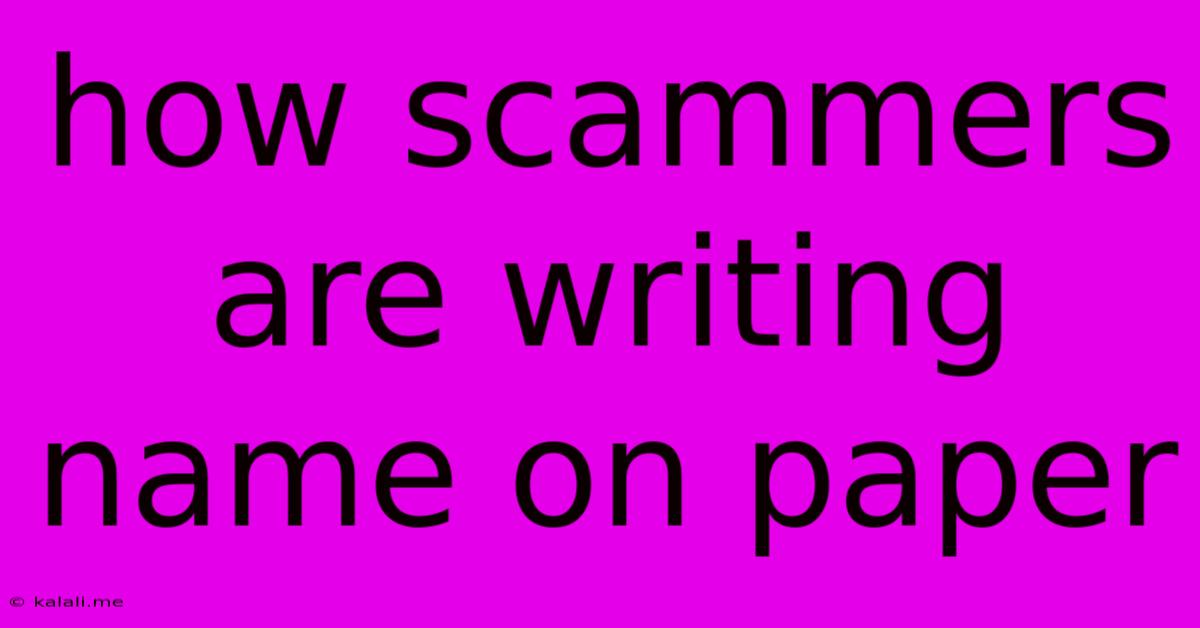How Scammers Are Writing Name On Paper
Kalali
Jun 02, 2025 · 3 min read

Table of Contents
How Scammers Use Handwritten Names: Unveiling the Tricks and Staying Safe
Scammers are constantly evolving their tactics, and one increasingly sophisticated method involves using handwritten names on seemingly legitimate documents. This seemingly simple act adds a layer of authenticity, making their fraudulent schemes more convincing. Understanding how scammers leverage this technique is crucial to protecting yourself from their deceptive practices. This article will delve into the methods scammers employ, the reasons behind their use of handwritten names, and most importantly, how you can identify and avoid these scams.
The Psychology Behind the Handwritten Name
The power of a handwritten name lies in its perceived authenticity. In our digital age, a handwritten signature often evokes a sense of personal touch and legitimacy. Scammers exploit this psychological bias, using handwritten names to make their fraudulent documents appear more genuine and less likely to be questioned. The perceived effort involved in handwriting a name adds to the illusion of legitimacy, making victims more likely to trust the document's contents.
Common Scamming Tactics Involving Handwritten Names
Scammers utilize handwritten names in various fraudulent activities, including:
- Fake Checks and Money Orders: Handwritten names on fraudulent checks or money orders are used to mimic legitimate financial instruments. The scammer may attempt to deposit the fraudulent check, then quickly withdraw the funds before the fraud is discovered.
- Counterfeit Lottery Tickets: Winning lottery numbers and handwritten names are frequently used on counterfeit lottery tickets. The victim may be convinced to pay fees or taxes to claim their "winnings."
- Phishing Documents: Handwritten names can be added to official-looking documents, like tax forms or legal notices, to increase their credibility and encourage the victim to disclose personal information. These documents often contain links or instructions to visit fraudulent websites.
- Identity Theft: In identity theft cases, scammers may use a victim's handwritten name on documents to access their accounts or commit other fraudulent activities. This may involve forging signatures on loan applications or credit card applications.
- Real Estate and Rental Scams: Handwritten leases or contracts with forged signatures are a common tactic in rental scams. The victim pays a deposit or rent to a scammer who has no legitimate claim to the property.
Recognizing the Red Flags
While a handwritten name itself isn't inherently suspicious, several red flags should raise your awareness:
- Poor handwriting quality: Inconsistent lettering, smudges, or unusual pen pressure can indicate forgery.
- Unusual paper quality: The paper may feel cheap or have an unusual texture.
- Grammatical errors or inconsistencies: Errors in spelling or grammar in the accompanying text should raise suspicion.
- Suspicious requests for payment: Be wary of any requests for immediate payment, especially if the communication seems urgent or pressured.
- Unverified sources: Never trust a communication from an unverified source. Always verify the sender's identity independently.
Protecting Yourself from Handwritten Name Scams
Staying vigilant is paramount. Here are some key steps to protect yourself:
- Verify the sender's identity: Always verify the sender's identity through independent channels before taking any action. Contact the company or organization directly using their official contact information.
- Never rush into decisions: Legitimate organizations rarely require immediate action. Take your time and consider the situation carefully.
- Be suspicious of urgent requests: Scammers often create a sense of urgency to pressure victims into making quick decisions without proper consideration.
- Check for inconsistencies: Scrutinize any documents carefully for inconsistencies in spelling, grammar, or handwriting style.
- Report suspicious activity: If you suspect you've encountered a scam, report it to the appropriate authorities immediately.
By understanding how scammers utilize handwritten names and practicing vigilance, you can significantly reduce your risk of becoming a victim. Remember, if something seems too good to be true, it probably is. Stay informed, stay safe.
Latest Posts
Latest Posts
-
Keep Some Vertices Locked In Place Blener
Jun 04, 2025
-
How To Fix A Cracked Bathroom Sink
Jun 04, 2025
-
How To Remove Bathroom Floor Tile
Jun 04, 2025
-
What To Choose Domain Or Url Console
Jun 04, 2025
-
Another Way Of Saying About Me
Jun 04, 2025
Related Post
Thank you for visiting our website which covers about How Scammers Are Writing Name On Paper . We hope the information provided has been useful to you. Feel free to contact us if you have any questions or need further assistance. See you next time and don't miss to bookmark.